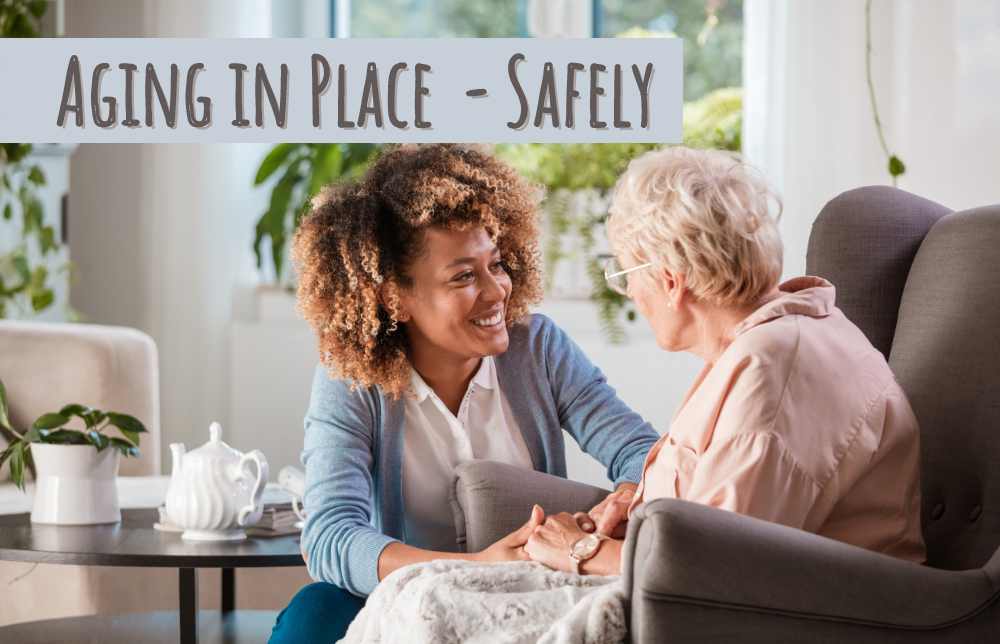
Aging In Place – Safely
March 31, 2022
80% of Americans age 50 and over say they want to continue living in their own homes. This is what is referred to by the U.S. Centers for Disease Control and Prevention as Aging In Place, which they define as “the ability to live in one’s own home and community safely, independently, and comfortably, regardless of age, income or ability level.”
Widely perceived as the “opposite” of assisted living, Aging In Place is, in fact, a viable option for many people today for several reasons:
- Experts have provided valuable advice and insights to make one’s home safer.
- Technology has greatly improved independent living.
- Many types of services and assistance are available in people’s own homes as they age.
Benefits Of Living At Home
The emotional benefits of living in a home of one’s own choice – whether a home filled with cherished family history and memories or moving to a house with features that are optimized for older adults - can offer significant benefits. Factors like staying close to family and friends and keeping community ties and routine get-togethers at favorite restaurants or favorite activities like playing cards or enjoying aerobic exercises can help to maintain the social connections that can help prevent cognitive decline later in life.
Aging In Place also offers significant cost savings. In 2017, the average national monthly cost for assisted living was $3,750, or $45,000 per year. Nursing home care is significantly more expensive, at $6,844 per month, or $82,000 per year. And with very few exceptions, none of these expenses are covered by Medicare. Staying at home (even with part-time housekeeping and home health aide help) is substantially less expensive.
Making Your Home Aging In Place Safe
Less than 25% of aging homeowners who want to continue living at home have a full bath and bedroom on the first floor of their homes. This is only one example of the need to make smart modifications to living spaces as we age.
Some others include:
Sensory aids: Brighter overhead and/or motion-sensitive lights can make a home safer. Alarm systems that include visual cues can also also be an improvement, especially if the person has hearing loss.
Stability: Installing safety railings and grab bars throughout the home, especially in bathrooms, hallways, and staircases, can significantly reduce the risk of falling or losing one’s balance. Replace slippery floor surfaces in kitchens and baths with non-skid flooring. Declutter to remove potential trip hazards. Remove throw rugs.
Get a grip: Replacing doorknobs with lever-style handles, and replacing traditional, handled faucets with touchless versions can be a great benefit for people with hands with reduced grip strength.
Smart Home Technology. From smart lights, thermostats, security systems, voice-controlled assistants, and robotic cleaning devices to smart pill cases that remind you if you’ve skipped a dose, technology has made it easier to continue living at home for many.
Prepare For The Unexpected
The possibility is that at some point, those who are Aging In Place may find themselves in need of additional help to continue living at home. That’s why having Home Healthcare Insurance is so important. IRTA and AMBA have a Home Healthcare Plan that makes it possible for you to stay in your own home with skilled assistance when faced with a medically necessary need for home health care. The plan pays you directly, in addition to any other health care coverage. You’re in control! Choose the amount of coverage, the number of covered weeks, and the duration of your waiting period. Home Healthcare Insurance is essential so you're prepared for the unexpected. Sign up now at (833) 784-2161 or click to request a free Benefits Review.
Source:
https://www.cdc.gov/healthyplaces/terminology.htm
https://www.wsj.com/articles/homeowners-get-ready-to-age-in-place-1432824961
RECENT POSTS
AMBA’s Essential Insights in Dental Health: Understanding Cavities
Have you ever experienced pain or noticed persistent sensitivity in your teeth? You might have a cavity. Cavities are common,
Read More
Keep “Looking” Your Best: The Unique Eye Health Challenges for Women Over 55
March is Women’s History Month, a time to celebrate women's contributions to American history and society. It’s
Read More

Leaving Your Home To A Loved One
If you’re like many people, your home represents more than just financial value. As the saying goes, "Home is where the
Read More

The Top Scams to Watch Out for in 2025
In our increasingly digital world, the top scams continue to evolve, with fraudsters developing new and sophisticated ways to
Read More

